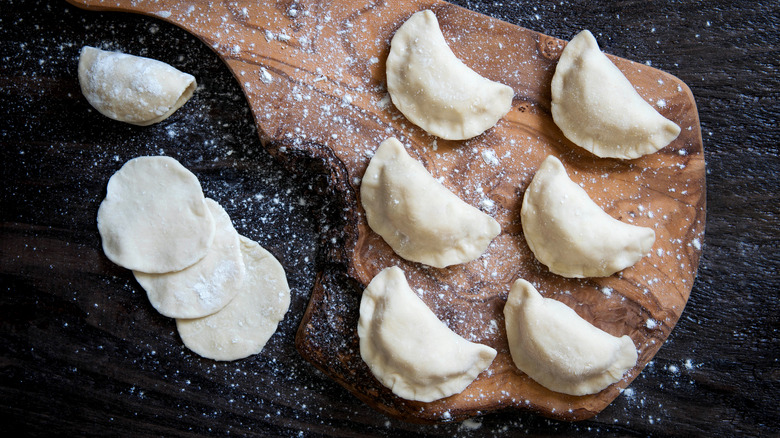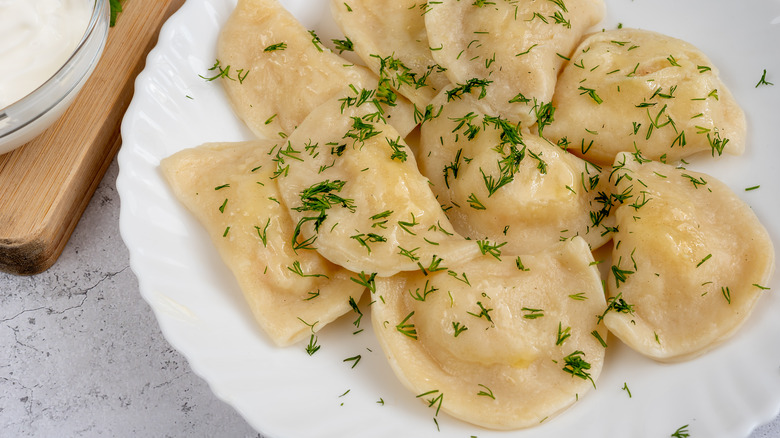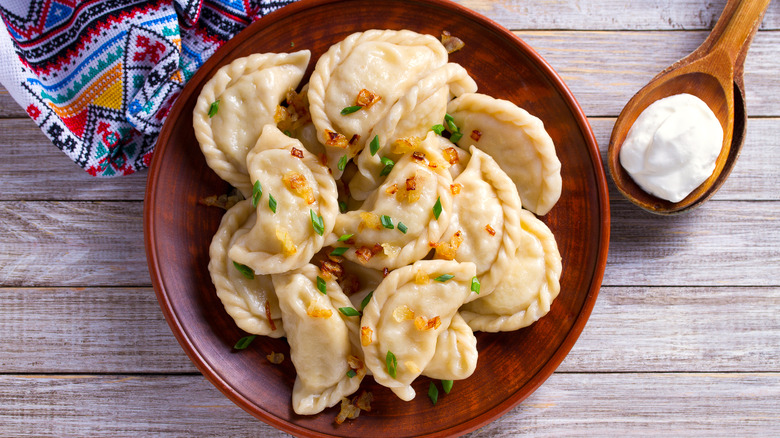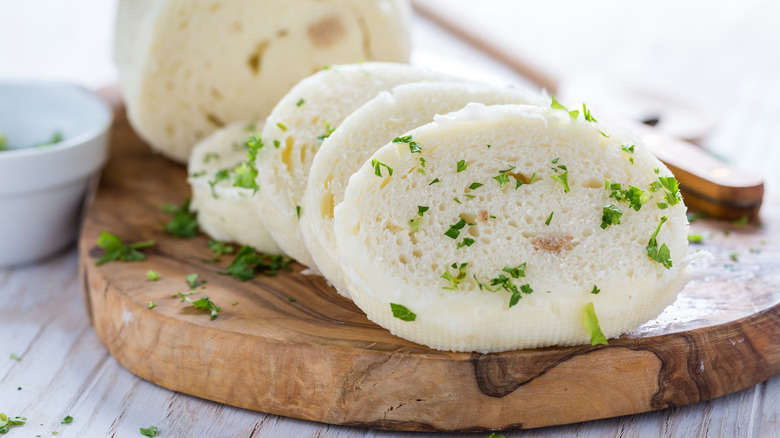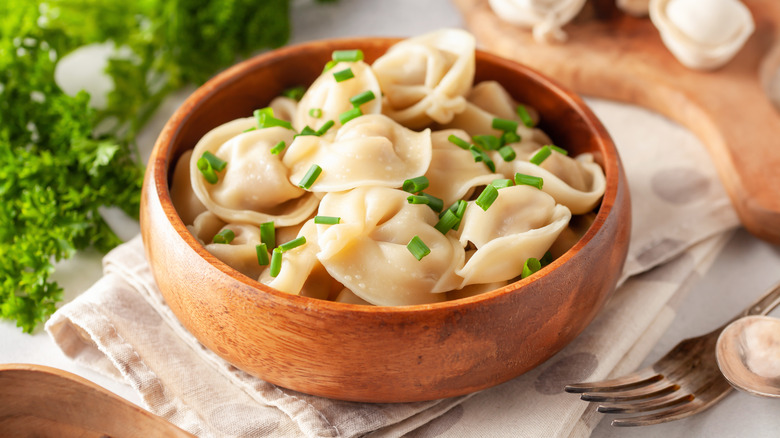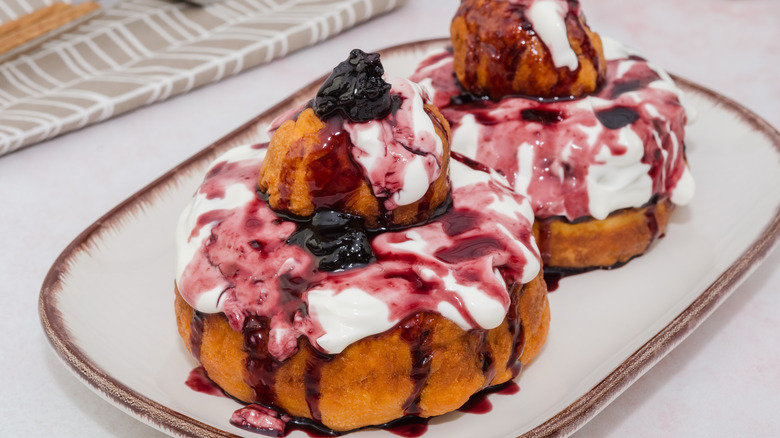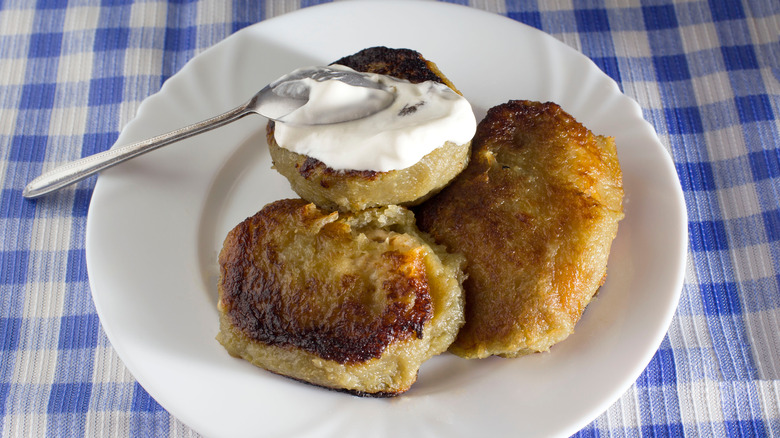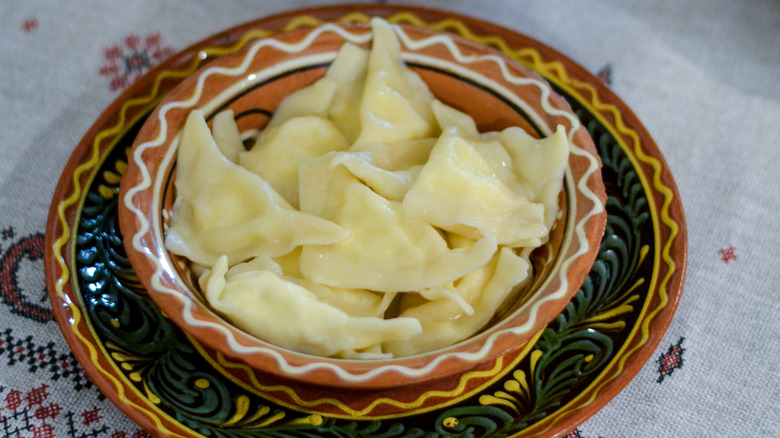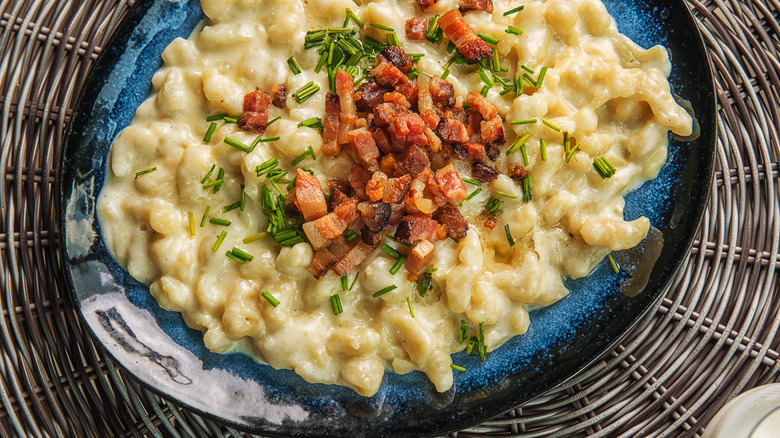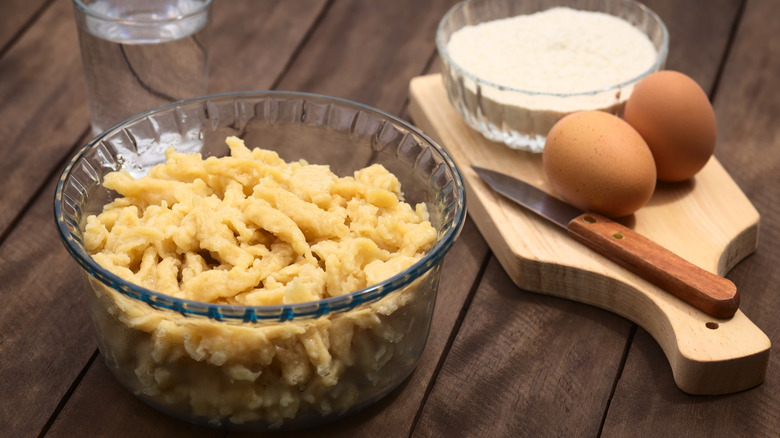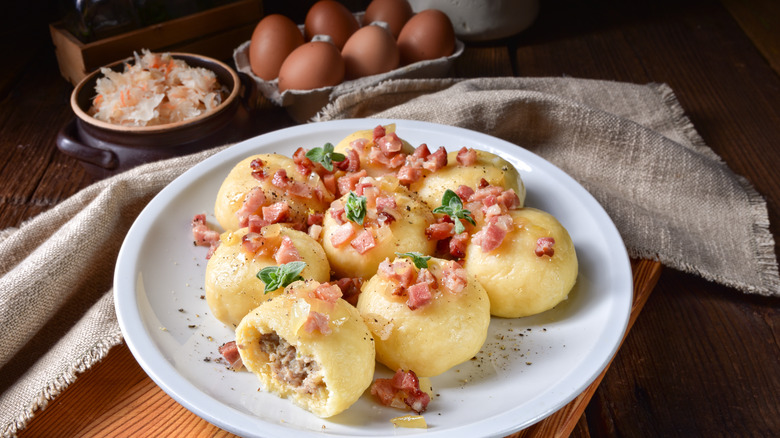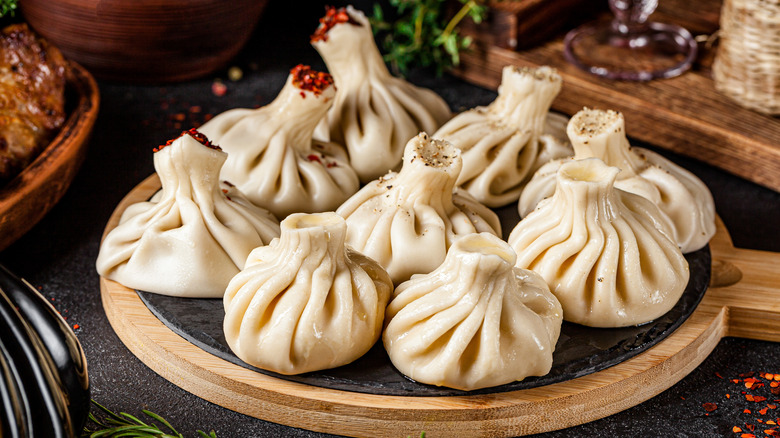11 Eastern European Dumplings To Try And Why
Food tells a rich story of the culture of a place, revealing history and details about how culinary traditions have survived and evolved. One dish that goes beyond borders and unites every country in the world while still retaining its own unique style is the humble yet mighty dumpling (via BBC Bitesize). Dumplings can be served as snacks, main meals, or desserts, and they are often made using simple ingredients following recipes that have stood the test of time. These soft bite-sized morsels really are the ultimate in home-cooking, remaining ever-popular regardless of modern-day food fads.
Much like the rich diversity among nations, dumplings are distinct yet universally part of the same family. Anthropologist and food scholar Eugene Anderson tells South China Morning Post that their roots seem to lead back to the Middle East. However, there's no doubt that the influence of Chinese dumplings on the dish's evolution has been great.
What's certain is this heartwarming comfort food transcends differences and unites all. It's time to discover the vast selection of Eastern European dumplings available so you can set out to taste them all.
1. Pierogi
Can you believe that there's a patron saint of dumplings in Poland? Among the various stories, one describes how Saint Hyacinth fed pierogi to the poor people of Krakow while they were under attack, BBC Travel explains. Meanwhile, another tale says that locals made pierogi to thank the saint for saving them during a terrible storm. Whatever the folklore, if you've never tasted pierogi, then you're missing out on a traditional dish that's been around for centuries (via Culture.pl).
Pierogi are made from wheat dough and shaped into half circles stuffed with an appetizing array of sweet or savory fillings. According to Culture.pl, the secret to great-tasting pierogi is to ensure the dough is soft, thin, and stretchy so that it doesn't overshadow the ingredients inside. The pouches are either boiled in salted water, fried, or baked. Pierogi are so wonderfully versatile, that your only challenge is to pick your favorite!
One of the most popular types is pierogi ruskie, which hails from what is now part of Ukraine. These are filled with potato and cheese, boiled until they're soft, and often served with onion, crispy bacon bits, and sour cream (via The Spruce Eats). Sweet varieties made with fruits such as cherries and bilberries are sometimes served as an entrée in the summer. Tasting Poland describes other regional fillings like sweet white curd cheese, lentils, and mint.
2. Vareniki
Ukrainian vareniki are doughy half-moons, similar to Polish pierogi and certainly just as loved. In fact, according to Ukrainian Recipes, there used to be a monument celebrating this dumpling in Ukraine. Nowadays, vareniki devotees can find a giant statue in Alberta, Canada, the country with the third largest Ukrainian population.
A feature on RFE/RL explains that vareniki dough is sometimes made using fermented milk products, and the dumplings are often steamed rather than boiled. Common fillings include cottage cheese, mashed potatoes, and meat, plus fried cabbage. Alternatively, fruit is added to make dessert dumplings, and another Ukrainian tradition entails stuffing them with boiled beans or buckwheat groats.
The delicious double-carb combo of soft dough and potatoes is a winner, while cheese and tasty fillings add a brilliant burst of flavor with each bite. Accompaniments enhance the flavor, and you'll want to load up on fried onions, fresh parsley and dill, and sour cream (via Ukrainian Recipes).
3. Knedliky
When it comes to Eastern European dumplings, the Czechs incorporate their own unique culinary traditions. Czech Specials notes that the national dumplings — knedliky — once referred to a dish that was essentially a mash-up of meat and bread rolls, presented in a long, loaf shape. Later, flour, yeast, eggs, and salt were added to make something similar to bread. However, knedliky are boiled in water and come in multiple variations.
Czech Specials describes one style where herbs and egg whites are added to the basic dough, giving the dumplings a wonderful lightness. Meanwhile, other kinds incorporate boiled potatoes, while wooly dumplings are made by combining raw grated potatoes into the doughy mix. These dumplings are often served in thick slabs like slices of bread, along with hearty accompaniments like beef in cream sauce and roast pork with cabbage.
Knedliky recipes can also include stale bread cubes, Feastern Europe, explains. The simplicity of the ingredients and the use of leftover bread highlight how the roots of these dumplings are firmly planted as a food for the people.
4. Pelmeni
Pelmeni are stuffed meat dumplings that originated in Siberia and the Ural mountains (via Russia-IC). The format was ideal for storing meat away from hungry animals in the wild, and they could easily be preserved frozen in the harsh Siberian climate. As for their name, pelmeni translates to bread ears in an ancient Eastern language, perhaps a description of their curved appearance, according to Bridge to Moscow.
Unlike Polish pierogi and Ukrainian vareniki, the dough is thinner and the filling is usually added while it's still raw (via RFE/RL). In Russia, the salt-seasoned meat filling of beef, lamb, or pork is spiced-up with pepper and garlic, though the dumplings can also contain cheese and vegetables. You'll find them with sour cream and dill on the side for a creamy herbal flavor. Butter, vinegar, and mustard are also sometimes served with pelmeni.
The dumplings come in a few sizes and the smallest is made by wrapping dough around the end of a finger. The mid-size dumplings are made with a series of twists and turns, ensuring that the delicious filling remains tucked away. Meanwhile, larger ones look a lot like Chinese fortune cookies. Pelmeni take just a few minutes to cook in salted boiled water and they can also be fried or sauteed (via Pel&Meni).
5. Papanasi
How does a sweet and savory fried cheese dumpling with sour cream and jelly sound? This is the beauty of papanasi, a dumpling dessert that's popular in Romania. Boiled papanasi originally come from Austria, while the fried versions are Moldavan. No matter the origin, all variations look decidedly donut-esque (via ImperialTransilvania).
According to Romania Insider, papanasi stand out thanks to the dessert's towering appearance. A large dough base with a hole is topped with a smaller dumpling ball. In between, expect to find a creamy, fruity layer. This is undoubtedly not the kind of dumpling to serve after a big meal, nor is it a light course by any means.
Papanasi dough is made with Romanian cottage cheese, eggs, baking soda, citrus zest, and flour. Larger and smaller dough balls are shaped and fried. Sour cream is loaded over the large base to fill in the hole, cherry preserves add a sweet tang, and the whole is topped off with a mini deep-fried dough ball. Papanasi are easily one of the most decadent dumpling dishes!
6. Kolduny
Just when you think the world of dumplings can't get any more appetizing, along come some stunning, starchy stars from Belarus. There are two different varieties of Belarusian kolduny: one made from potatoes and the other with unleavened flour dough (via Matador Network). The potato version is made by squeezing excess liquid from finely grated raw potato to make the mass more compact, Chef's Pencil explains. The potato cake is filled with meat (usually pork) or river fish with boiled eggs, then fried and served with sour cream on the side.
The floury variety is smaller than Polish pierogi but otherwise similar. The dumplings are filled with meat and Polish Your Kitchen indicates that they are often served in a simple broth. The soft dough is made with eggs, oil, and sometimes soda, resulting in a stretchy consistency. Meanwhile, an article on Bicheli explains that the dumplings can also be stuffed with mushrooms, fish, or cheese, and served with various sauces to match the fillings.
Sweet kolduny can also be prepared with a fruity center for dessert. Bicheli describes that large kolduny are served as part of special Muslim feasts. The filling is eaten with a spoon straight from the cooked dough so that it remains intact and acts as an edible bowl to keep the meat juices inside. With so many ways to enjoy them, you had better get around to tasting kolduny soon!
7. Colțunași
Located between Ukraine and Romania, Moldova is home to two types of colțunași dumplings: Colțunași harnici translates as hard-working dumplings, while colțunași lenoșia (the easier version) means lazy dumplings. These types of dumplings are made from unleavened dough simply made with flour, salt, water, eggs, and oil. The filling typically includes cheese and potatoes (via Wine of Moldova USA). Nonetheless, variations such as cabbage, roasted onions, or even cherries are also common (via Moldova Travel).
The harder method is similar to most dumpling recipes: You make the dough, roll it out, and stuff it with the filling. As for the simpler technique, Nomad Paradise explains that the dough ingredients are mixed with the filling (usually just cheese), and the result is chopped up into pieces that become the dumplings. Either way, colțunași are boiled in salted water.
To really savor these cheesy dumplings, season them with chopped herbs on top and a drizzle of olive oil. Alternatively, serve them along with a braised stew and don't forget the sour cream. Not only are colțunași delicious, but they're also nice and big so you can get your fill.
8. Halušky
Gnocchi-style dumplings made from potato dough are served with deliciously salty cheese in Slovakia's national dish. Halušky is not only a cheese lover's delight, but it will also satisfy bacon fans with the crunchy fried bits sprinkled over top. Simple fare, this Slovakian dish reflects the country's culinary heritage with the use of bryndza sheep's cheese, which The Culture Trip describes as similar to feta. Will Fly For Food notes that these doughy, cheesy dumplings are a fitting dish for the no-doubt hard-working agricultural lifestyle traditionally common among many Slovakians.
The Spruce Eats points out that while gnocchi is made from dough and halušky from a batter, they're both cooked in the same way — tossed into boiling water for just a few minutes. If you want to try preparing this dish at home, the dumpling mix starts with pureed potatoes. Flour and salt (sometimes egg) are mixed in, creating a thick consistency. Small pieces of batter are dropped into a pan of boiling water until they rise to the surface. Served with tangy cheese and fried bacon bits, this Eastern European version of macaroni and cheese is so creamy and comforting.
9. Nokedli
As a part of the culinary culture of Hungary, nodekli (typically called galuska on restaurant menus, per Hungary Today) are the perfect accompaniment for chicken paprikash, according to Hungarian Tidbits. The small, egg-noodle dumplings are deliciously craggy which makes them great at holding onto sauce. With that in mind, they are an ideal pairing with hearty Hungarian goulash or else a great alternative to everyday pasta. These are quick, easy, and fun to make if you're up for getting your hands a bit dirty. Plus, the dough cooks in boiling water in a matter of minutes.
Hungary Today explains that the dish likely has Austrian origins, although some stories suggest they stem from Italian gnocchi. Nevertheless, they have taken on a life of their own in Hungary where they are enjoyed by all. Traditionally, the dumplings provided nourishment throughout the winter months when crops were scarce. Nowadays, eating them year-round is not out of the question.
10. Pyzy
Round doughy dumplings with a slightly crunchy outside and a hidden filling on the inside, potato pyzy are another delicious dumpling made by the Poles. The dough for these tasty pockets is made with flour, salt, eggs, and potatoes (mashed or grated raw). The result is shaped into a ball and can be cooked as is, or stuffed with minced meat or cottage cheese filling. Fried in a little oil, the outside of the dumpling browns and crisps up, while crispy bacon bits and onions are added over top at service (via Taste Atlas).
Rosa Cooking notes that the dumplings can be served as an entrée, along with a stew, and even for dessert. She recommends testing out various options and trying fun ingredients like sugar and cream or salami. It really is a case of experimenting with the fillings, to come up with a version that tastes divine.
11. Khinkali
Georgia's khinkhali are deserving of a place in any list of superb Eastern European dumplings. Before getting into the details, a presentation by RFE/RL instructs diners to put their knives and forks away. Apparently, Georgian people eat these delicious dumplings with their hands. Conveniently, khinkhali have a twisted top that you can hold onto for easy handling.
Taste Atlas describes that the dumplings are typically filled with meat and seasoned with spices. In the mountainous regions, lamb is traditionally used instead of pork and beef. The meat is added raw so that it cooks within the dumpling, creating a juicier result. However, if you prefer a meat-free version, khinkhali can also be prepared using cheese and mushrooms. The fillings vary significantly according to regional specialties, highlighting this down-to-earth fare in a number of ways.
At service, the dumplings are seasoned with pepper so that the flavorful juices take center stage with each bite. Meanwhile, the folded stem used to hold onto isn't eaten but instead, is thrown away because it's too tough. Of course, the only bad news here is that everyone can see from your doughy leftovers how many khinkhali you've scarfed down.
